Is There a Case Where You May Not Choose to Deploy a Firewall?
What line of defense do you have against malicious traffic and software? Do you have a firewall protecting your infrastructure?
Security is at the forefront of the technology discussion. As the industry innovates and builds websites, applications, and platforms, securing the environments where these things live is increasingly essential. In the web hosting space, there are many options for securing your infrastructure.
But how do you know which ones to choose?
A firewall can prove to be a simple, effective, and modest solution for data security. We want to take some time to discuss firewalls and their use to secure data. We will specifically look at:
- What is a Firewall?
- What is the Purpose of a Firewall?
- How Firewalls Work
- What is the Difference Between a Hardware vs Software Firewall?
- What are the Types of Firewalls?
- What are Some Firewall Use Cases?
What is a Firewall?
A firewall is a device used in network security to monitor incoming and outgoing network traffic and determine whether to allow or block it based on a predetermined set of security rules. You can refuse access to unauthorized traffic, while legitimate traffic can be allowed to reach its destination. Firewalls also block malicious software from infecting your computer.

What is the Purpose of a Firewall?
The purpose of a firewall is to reduce or eliminate unwanted network connections and increase the free flow of legitimate traffic. Firewalls are an essential addition to your infrastructure because they can help to isolate computers and servers from the Internet to provide security and privacy of data. As previously mentioned, not only do they monitor traffic to and from your server, but they limit that traffic in some cases as well. Having this type of protection in place can prove to be invaluable.
For example, if we think about a Denial of Service (DoS) attack, erroneous traffic floods your site and can potentially bring down the targeted website's server. Appropriately configured firewalls serve to protect your environment from such situations. You can filter traffic and search patterns for anomalies that point to an attack being underway.
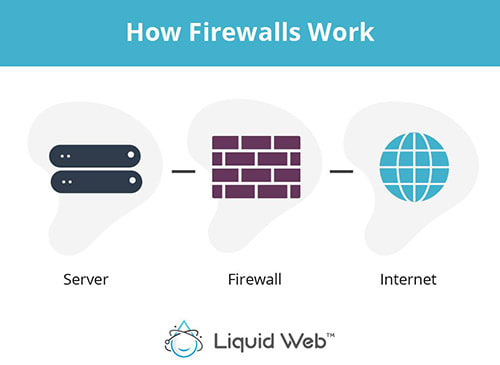
How Firewalls Work
A firewall monitors all data traffic to allow good data and block bad data based on preset rules in its basic functionality. It uses one or any combination of three methods: Packet Filtering, Stateful Inspection, and Proxy Service.
The Packet Filtering method gets implemented to monitor network connectivity. Data packets are units of data packaged together and traveling along a given network path. The packages are analyzed and compared against the configuration rules or "access-list." It then determines what is allowed or denied access to your environment.
Stateful Inspection method allows the analysis of traffic flow patterns according to state, port, and protocol. The way this works is by the firewall monitoring activity on a connection from open to close. It keeps track of known, trusted packets to determine authorized data from the website or app versus any data from hackers or other unauthorized sources.
The Proxy Service methods prevent direct network connections between Internet traffic and the server. This type of implementation takes stateful inspection a step further. The firewall would act as an intermediary between your server and the requests made by the end-user. Entire data packets are examined and either blocked or allowed based on the rules set.
What is the Difference Between a Hardware vs Software Firewall?
There are hardware and software firewall solutions from which to choose. Whether you need one or both types of firewalls depends on what you are trying to accomplish. However, if you are not using at least one of these methods to protect your environment, you may be vulnerable to nefarious network activity.
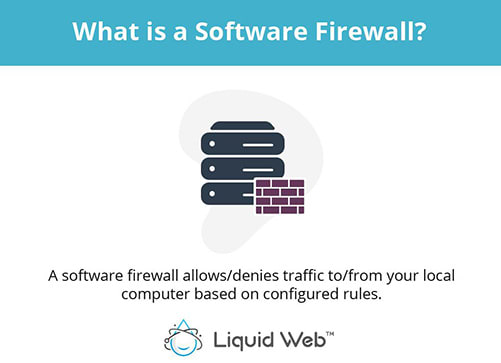
What is a Software Firewall?
A software firewall is a firewall installed on your local computer that allows or denies traffic to and from your computer based on configured rules; it does not require any physical set up.
They are installed locally on the device or devices you are trying to protect. You have much more granular control of the rules set up for each specific device running the software. Traffic can be analyzed down to the content and blocked based on keywords contained therein.
Since the software firewall is local, it is typically efficient with security alerts. Whether managing rules or users, administrators can refer to logs or notifications to determine what is happening on the devices. Knowing what is taking place on your systems at a moment's notice works in your favor.
However, for software firewalls to work, the software would need to be installed on each device in your network. If there is no hardware firewall between the Internet and your system, your infrastructure could be susceptible to attacks. It is also essential to ensure compatibility between your operating system and the software you wish to use. No matter how good the software, compatibility issues weaken the effectiveness of your security.
One small factor to note is that software firewalls can be intensive on your device's resources. While computers and servers with more capable hardware may not notice much of a difference, those with limited resources can slow down with some software firewalls. The more lightweight the software, the better your environment will run.
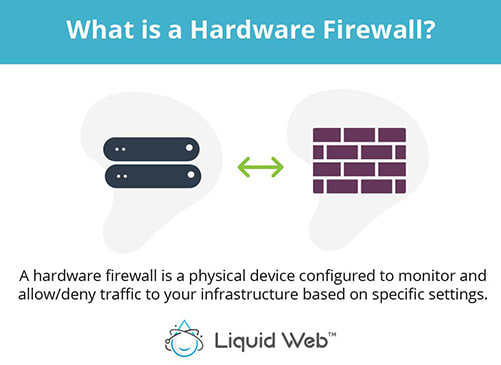
What is a Hardware Firewall?
A hardware firewall is a physical device configured to monitor and allow/deny traffic to your infrastructure based on specific settings, and allows for the highest performance on your servers by keeping the firewall separate from your server.
Having a hardware firewall ensures you have 100% control of the traffic on your network. With a single device, you can decide what traffic should or should not reach your servers. There is no need to install or enable software firewalls as packets to be intercepted and analyzed before reaching your servers.
Hardware firewalls are also easily configured. There are usually default rules you can set and apply to all traffic. Granular control to drill rules down to distinct ports and services like SSH and RDP makes fine-tuning simple.
Another benefit to hardware firewalls is the ability to set up a Virtual Private Network connection directly to your environment. Wherever there is a stable Internet connection, you can access your infrastructure. Moreover, with managed hosting providers like Liquid Web, you get help with managing and configuring your VPN tunnel.
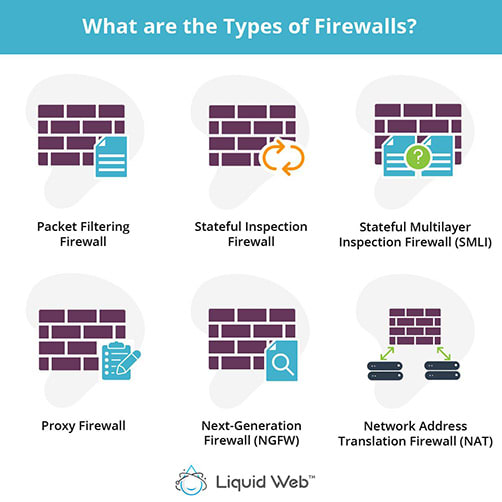
What are the Types of Firewalls?
There are six different types of firewalls:
1. Packet Filtering Firewall
Packet Filtering is a specific method for implementing a firewall to monitor network connectivity. Data packets are analyzed and compared against the configuration rules or "access-list." It then determines what is allowed or denied access to your environment.
2. Stateful Inspection Firewall
Stateful Inspection techniques allow the analysis of traffic flow patterns according to state, port, and protocol. It monitors activity on a connection from open to close. The firewall keeps track of known, trusted packets to determine authorized data from the website or app versus any data from unauthorized sources.
3. Stateful Multilayer Inspection Firewalls (SMLI)
Stateful Multilayer Inspection Firewalls filter data packets at the network, transport, and application layers. SMLI firewalls examine entire data packets and compare them against trusted ones. They only allow them to pass if they pass each layer individually, ensuring all communication takes place with trusted sources.
4. Proxy Firewall
Proxy-based firewalls take stateful inspection a step further, preventing direct network connections between Internet traffic and the server. The firewall acts as an intermediary between your server and end-user requests. Entire packets are examined and either blocked or allowed based on set rules.
5. Next-Generation Firewalls (NGFW)
Next-Generation Firewalls combine conventional firewall technology with additional functionality. Traditional firewalls only inspect packet headers. Like SMLI firewalls, Next-Gen firewalls analyze data within the packets to identify and stop malicious data more effectively.
6. Network Address Translation Firewalls (NAT)
NAT firewalls are similar to Proxy firewalls, acting as intermediaries between a group of computers and outside traffic. It acts as a private network, allowing multiple devices with independent network addresses to connect to the Internet with a single IP address. Devices behind this firewall remain hidden and unsolicited communication is blocked.
Now that we have discussed what a firewall is, how it works, and the different types, let's talk about some use cases for firewalls.
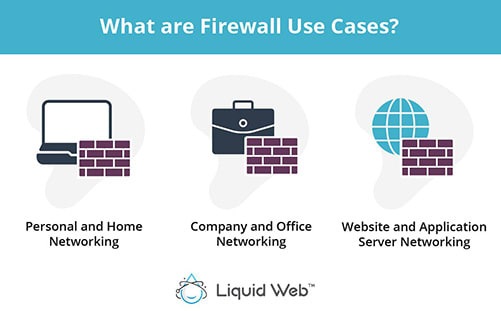
What are Some Firewall Use Cases?
Personal and Home Networking
Those people that work or play from their home Internet connection most certainly need a firewall. In most cases, some firewall form gets used in most operating systems, home network routers, and antivirus software. Unless there is a need beyond these standard methods, not much else is necessary. You can certainly consult with your Internet Service Provider or an Information Technology professional for assistance with home networking.
Company and Office Networking
Your office or place of business also needs security outside of the basics. Whether your infrastructure is set up in-house or hosted with a provider, ensuring data to and from your servers is legitimate and protected is a necessity. It is worthwhile to explore solutions for protecting your data and your servers.
Website and Application Server Networking
Hosting sites and applications with a managed provider still warrant a secure environment. DoS attacks, malware, and other exploits to software vulnerabilities are just a few things hackers deploy. With the proper configuration and rules in place, you can lock down your websites and applications from those out to get your data.
Struggling to Secure Your Infrastructure? Download our Complete Cybersecurity Checklist for SMBs.
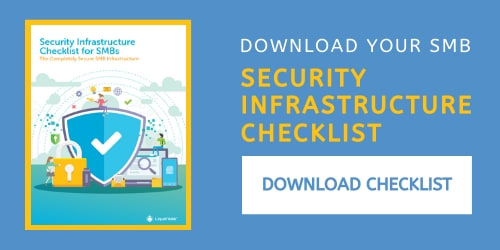
Is There a Case Where You May Not Choose to Deploy a Firewall?
Source: https://www.liquidweb.com/blog/what-is-a-firewall/
0 Response to "Is There a Case Where You May Not Choose to Deploy a Firewall?"
Post a Comment